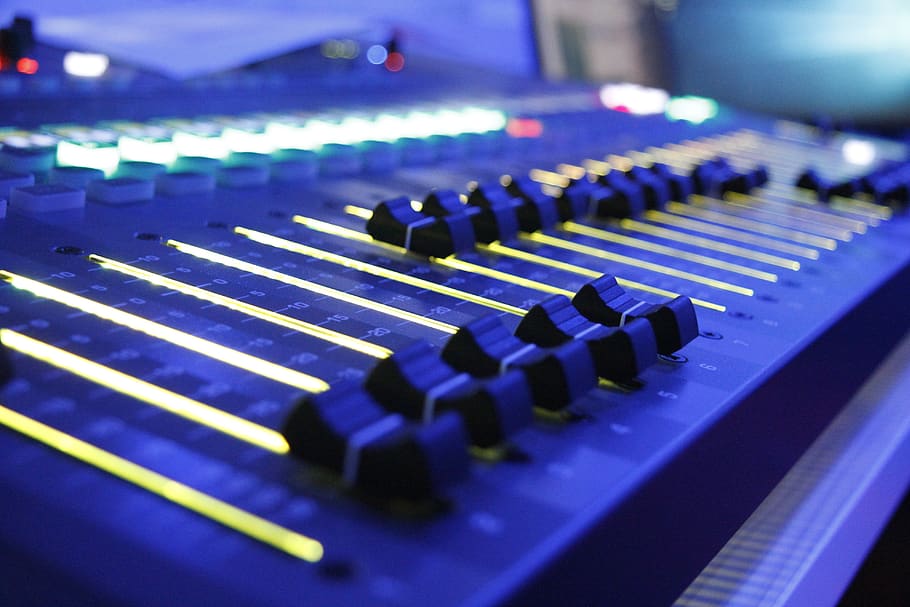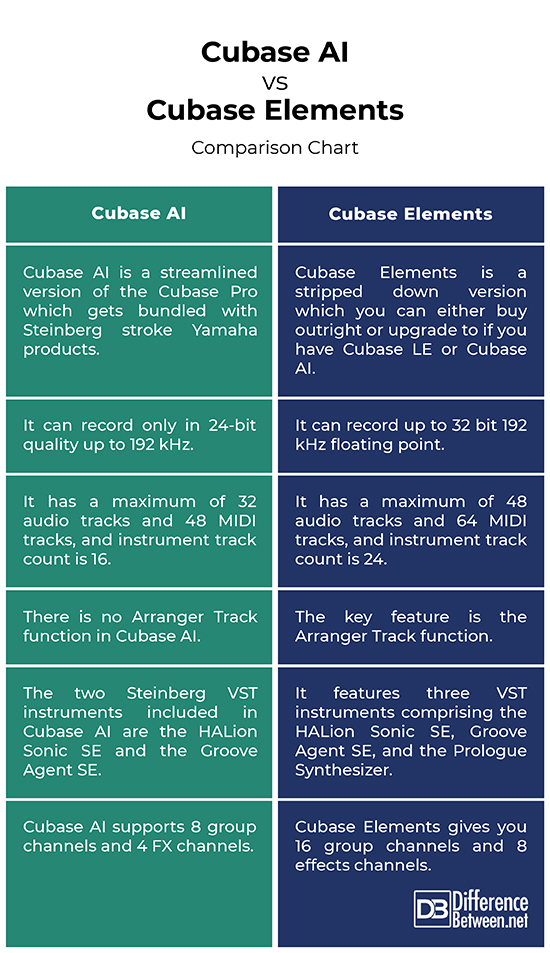Difference Between Cubase AI and Elements
Cubase is a digital audio workstation (DAW) and one of the world’s most powerful music creation software packages developed by Steinberg Media Technologies, a global leader in audio software and hardware solutions. Based in Hamburg, Germany, Steinberg develops and sells innovative music recording, arranging and editing software, notably Cubase. Steinberg is a wholly owned subsidiary of the world’s leading manufacturer of audio hardware, Yamaha Corporation. With a whole range of flexible tools, Cubase helps you create just any kind of music quickly and intuitively. All versions of Cubase allow you to perform a multitude of music production tasks within a single, streamlined software environment.
The very first version of Cubase ran on the Atari ST computer and was released in 1989. At that time, it featured the revolutionary ‘Arrange’ window which allowed musicians to arrange their musical compositions in a big graphical display, which was divided vertically into tracks. In 1996, Steinberg introduced the concept of VST (Virtual Studio Technology) and Cubase became Cubase VST. In 2002, Cubase SX was introduced based on the Steinberg’s flagship post-production software Nuendo. Cubase comes in several versions. We pit the two versions of Cubase – the Cubase AI and Elements – against each other.

What is Cubase AI?
Cubase Advanced Integration, or simply known as Cubase AI, is one of the entry-level offerings of the Steinberg’s flagship music production software which provides all the basic tools for recording, editing and mixing for all genres. In this version, you can have a maximum of 32 audio tracks and up to 48 MIDI tracks. It offers some powerful composition tools and features some outstanding Steinberg VST instruments comprising the HALion Sonic SE and the Groove Agent SE.

What is Cubase Elements?
Cubase Elements is a step up from the Cubase AI which can be bought outright or can be upgraded to if you already have the Cubase AI or Cubase LE. It runs on the award-winning 32-bit floating point and it has a maximum of 48 audio tracks and 64 MIDI tracks, and 24 instrument tracks with full automatic delay compensation and flexible routing, which is more than enough for what you’re planning to do.
Difference between Cubase AI and Elements
Version
– Cubase is one of the most powerful music creation software packages in the world and one of the best digital audio workstations available for mixing video soundtracks and surround sound projects. AI is a streamlined version of the Cubase Pro which gets bundled with Steinberg stroke Yamaha products. It provides all the basic tools for recording, editing, and mixing for all genres. Cubase Elements, on the other hand, is a stripped-down version available with the basic audio editing toolset which you can either buy outright or upgrade to if you have Cubase LE or Cubase AI.
Audio/MIDI/Instrument Count
– Cubase Elements runs on the award-winning 32-bit floating point meaning it can record up to 32 bit 192 kHz whereas Cubase AI can record only in 24-bit quality up to 192 kHz. Talking about audio track count, Cubase AI has a maximum of 32 audio tracks whereas Cubase Elements has a maximum of 48 audio tracks. In addition, Cubase AI supports up to a maximum of 48 MIDI tracks whereas Elements supports up to 64 MIDI tracks. Instrument track count is 16 in Cubase AI and 24 in Elements.
Arranger Track
– One of the key features of the Cubase Elements is the ‘Arranger Track’ function which allows you to play different sections of your musical arrangements in any order you want without moving anything, even in live performances. There can be only one Arranger track in each Cubase project and it is managed in the Project window. This way, you do not have to move, copy and paste events in the Project window. On the contrary, there is no Arranger track function in Cubase AI.
Instruments and Inserts
– Cubase AI offers outstanding composition tools and features some powerful Steinberg VST instruments comprising the Cubase AI are HALion Sonic SE, a versatile sound production tool and Groove Agent SE, a wonderful tool for creating amazing beats. Cubase Elements, on the other hand, features three VST instruments comprising the HALion Sonic SE, Groove Agent SE, and the Prologue Synthesizer to help create powerful bass sounds. Coming to the maximum number of inserts you can have on an audio channel; Cubase AI has full inserts while Cubase Elements allows you to have eight inserts per audio channel.
Other Features
– You can have eight group channels and four FX channels with Cubase AI but Cubase Elements gives you 16 group channels and 8 effects channels to work with. Cubase Elements also allows you to add dither to your audio signal to minimize the effect of quantization errors in order to trade a little bit of low-level noise. Plus, Elements is equipped with the ‘Hermode Tuning’ system to help your tunes you play dynamically richer, and the ‘Remote Control Editor’ which gives you a convenient way to control your VST plug-ins from an external control surface. Cubase AI, on the other hand, has no Dither Effects, no Hermode Tuning system, and no Remote-Control Editor.
Cubase AI vs. Cubase Elements: Comparison Chart

Summary of Cubase AI vs. Cubase Elements
In a nutshell, Cubase AI is ideal for entry-level music production work which provides all the basic tools for recording, editing and mixing for all genres, and it offers outstanding composition tools and features some powerful Steinberg VST instruments comprising the HALion Sonic SE and the Groove Agent SE. It generally comes bundled with Steinberg stroke Yamaha products. Cubase Elements, on the other hand, is firmly aimed at the beginner thanks to its basic audio editing toolset, but with an outstanding range of editing and sequencing tools, equally appreciated by the musicians around the world.
- Difference Between Caucus and Primary - June 18, 2024
- Difference Between PPO and POS - May 30, 2024
- Difference Between RFID and NFC - May 28, 2024
Search DifferenceBetween.net :
Leave a Response
References :
[0]Collins, Mike. Pro Tools for Music Production: Recording, Editing and Mixing. Abingdon, England: Taylor & Francis, 2004. Print
[1]Millward, Simon. Fast Guide to Cubase 4. Norfolk, United Kingdom: PC Publishing, 2007. Print
[2]Collins, Mike. Choosing and Using Audio and Music Software: A Guide to the Major Software Applications for Mac and PC. Boca Raton, Florida: CRC Press, 2004. Print
[3]Miller, Michael. Mixing Music (Idiot’s Guides). Indianapolis, Indiana: Alpha Books, 2016. Print
[4]Image credit: https://c0.wallpaperflare.com/preview/610/607/714/dominican-republic-santo-domingo-mastering-engineering.jpg
[5]Image rcedit: https://c0.wallpaperflare.com/preview/836/431/717/mixer-mix-fader-console.jpg
